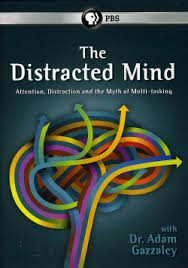From LPB co-founder Irene Madrid. Grandmother, lifetime credentialed teacher, child lover and studier:
Developing attention, focus and questioning the concept of multi-tasking has recently been in the news along with how electronics affect the wiring of our brains.
In the DVD "The Distracted Mind," with neuroscientist Dr. Adam Gazzaley, the myth of multitasking comes to fact in his lab at UCSF.
While our brain enjoys the challenge of doing several things at once, brain scans reveal the prefrontal cortex (the discerning and decision making areas of the brain) shows that activity jumps around from one part of the brain to another, as attention shifts.
One statistic showed that when we are driving and using a hands free phone, it places us in four times the risk of an accident.
Utilizing this information for best learning outcomes in children, we know focusing on one piece of information at a time is optimal.
There is a lot we can do to enhance our children's learning and attention span. If a task is very important, says Dr. Gazzaley, then TV, the iPhone or other distraction brings poor results. If the activities are fun and don't need accuracy, it can be consciously chosen in a recreational way.
In his lab, Dr. Gazzaley has measured the amount of undeveloped prefrontal cortex from children ages 5 to 20. The more green areas that showed up, the less able the person was to make good decisions. Even 20 year olds have pockets of green! Of course, that is why asking a child their opinion for doing chores, learning to swim or what they wish to eat for dinner makes very little sense.
As children grow, a good way to help decision making is to give limited choices in small things. When children show they can handle making good decisions, choices can also grow.
More concerns in neuroscience today are the issues of possible addiction to electronics. Electronics are taking the place of social interaction and experts say studies indicate less empathy development with lots of electronic use.
In the movie "Avatar," they greet each other with, "I see you." We now know when children beg caregivers to, "Watch me!", this helps children to enhance their self identification. There is hard wiring from the brain to the eyes which responds positively to being seen.
Dr. Gazzaley relates the story of two third grade girls who went to opposite sides of the playground so they could text each other. Since 97% of our communication comes from body language and voices, this is how we socialize and communicate best.
Dr. Gazzaley interviewed high school students who admit that when they cannot use their electronics, they become filled with anxiety. The teens also admitted when they have boundaries for electronics, they have better scholastic and social outcomes.
More studies need to be done and more scientists are interested in this broad field. In the meantime, we can use this information for our families.


No comments:
Post a Comment